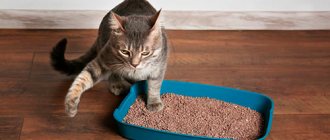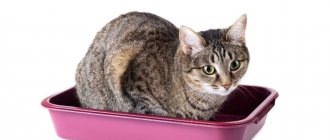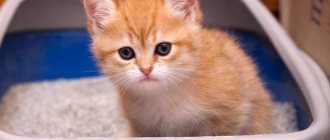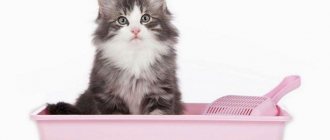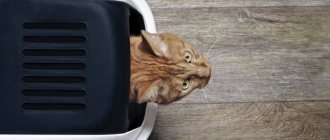If the kitten is healthy, this is immediately obvious: it constantly runs, climbs into strange places, hunts for enemies visible only to it, or for birds in the window.
Like human children, cat babies cannot plan their energy distribution. The kids will play and fuss until they fall asleep right there, buried in their toys.
How to properly give an enema to a small kitten.
How to properly give an enema to a small kitten.
How to properly give an enema to a small kitten.
How to properly give an enema to a small kitten.
A balanced diet is very important for a growing body. The kitten's body is very sensitive and demanding of food. Anything that goes wrong immediately results in either diarrhea or constipation.
A conscientious owner should pay special attention to choosing the right food for a small kitten.
But if constipation occurs, you need to know how to get rid of it gently and safely.
Causes of constipation
With prolonged feeding of solid food and a sedentary lifestyle, stagnation of chyme mass may form in the small intestine. This is the semi-digested contents of the kitten's stomach.
This phenomenon is called chemostasis.
If a kitten is fed bones, a plug of dry feces may form in the small intestine. It will clog the lumen and reduce intestinal permeability to zero.
The intestines can become blocked by accidentally swallowed objects, hairballs, or worms.
How can you tell if your kitten is constipated?
Usually it is not difficult for the owner to guess that the kitten is not in the best shape. The baby behaves restlessly, which is associated with the occurrence of colic, shortness of breath and vomiting. The abdomen swells due to accumulated gases; the animal cannot go to the toilet for more than two days.
If you try to palpate the abdominal wall, then, with certain skills and dexterity, you can feel an oblong lump or foreign body in the intestine.
With intestinal obstruction, in addition to the above symptoms, fever is added, the pulse becomes rapid, and breathing becomes intermittent.
Other reasons for an enema
An enema is not only done to relieve constipation. Indications may also include poisoning or severe exhaustion. In the first case, it is needed to quickly remove harmful substances from the body. And in the second - to quickly feed the kitten if it cannot eat.
Enemas can also be medicinal, when it is not possible to administer the medicine in any other way, and relaxing - to relieve intestinal spasms.
How to properly give an enema to a small kitten.
How to properly give an enema to a small kitten.
How to properly give an enema to a small kitten.
How to properly give an enema to a small kitten.
Brief conclusions
The process is unusual and painful for a cat, so it is not recommended to start an enema without preparation.
Here are the basic tips:
- We carry out the procedure on an empty stomach, preferably in the morning.
- We use only the recommended solution in the dosage that can be administered according to the weight and age of the pet.
- Making an enema with Microlax is the easiest and safest way. But before that, be sure to read the instructions.
- We remember that constipation can be caused not only by stool clots, but also by congenital anomalies or inflammatory diseases.
- If an enema does not help, be sure to listen to the veterinarian’s recommendations, or better yet, visit the clinic (for an ultrasound and tests).
- You can’t exclude natural products from your pet’s menu, including fermented milk and vegetables.
- Special premium canned foods perfectly regulate the gastrointestinal tract to stimulate peristalsis. Probiotics and feed additives do the job just as well.
Remember: an enema is a simple, but very serious procedure that can both help and harm. This express method can remove the consequences of gastrointestinal disturbances, but it does not cope with the cause of the disease.
Therefore, when starting to cleanse the intestines, treat everything that happens responsibly. If the injected solution does not help the cat to empty its intestines, it is better not to hesitate and immediately seek professional advice. Be sure to monitor the animal’s further well-being after the procedure.
And if your cat, on the contrary, has diarrhea, read how to treat it at home.
How to do an enema yourself
First of all, you must be sure that an enema is necessary and that constipation is not caused by volvulus or obstruction.
It is best to use a small bulb, although you can make an enema with a large syringe with a wide hole.
All procedures should be performed in the bathroom or on the bare floor so that it can be easily washed later. There should be a cat litter box nearby. And stock up on napkins or unnecessary rags.
The water in the pear should be warm. For lubrication, use Vaseline, baby cream or regular vegetable oil.
When everything is ready, place the kitten on your lap with its muzzle facing you, holding its head and back between your legs. Be careful: you should measure your strength with the size of the kitten. Make sure he can't escape and at the same time don't choke him.
Lift the kitten's tail, lubricate the anus with Vaseline and insert the tip of the bulb into the rectum. It is enough to immerse it 1-2 cm. Gently press the bulb and pour the water from it into the kitten. The volume of water should be in the range of 50-100 ml.
Then remove the bulb, gently squeezing the anal folds so that the water does not flow out immediately. If the kitten allows, you can lightly massage its tummy to enhance the effect.
After the procedure, do not let the kitten run around the apartment or hide in other rooms. Keep him in the same room as the litter box. So that he can easily reach it (perhaps with your help) when he wants to go to the toilet.
When does a cat need an enema for constipation?
The reason for the procedure may be various obvious symptoms of constipation, as well as a general deterioration in the pet’s condition:
- Long-term absence of stool – in cats up to 3-4 days. Or there is stool, but it is visually determined as unnatural for a healthy animal.
- The general health of the cat is cause for concern - there is no appetite, the cat is lethargic, goes to the toilet, but feces comes out in small quantities.
- A tight belly, discomfort caused by any touch to the abdomen - the cat itself will show you by its behavior that something untoward is happening.
- The animal cannot empty itself on its own - the cat meows, behaves unnaturally, there are attempts to go to the toilet, but they were not successful.
- Vomiting and malaise - the cat is lying down and does not even approach food, there has been no stool for several days - the pet’s well-being is clearly alarming.
Read how else you can cure constipation in a cat.
It's easier with an assistant
If you have a helper, trust him to hold the kitten. And carry out all the procedures yourself. This will free up your hands and make it more convenient.
How to properly give an enema to a small kitten.
How to properly give an enema to a small kitten.
How to properly give an enema to a small kitten.
How to properly give an enema to a small kitten.
Contraindications
When infusing liquid, albeit under slight pressure, the intestinal walls can be damaged by a tool or by stretching.
And since the cat has to be given an enema by force, the risks increase - the pet, instead of the necessary relaxation, violently resists. It will not be possible to secure an adult animal without an assistant. You should not carry out the procedure yourself if the cat is weakened, suffers from fever, uncontrollable vomiting, or dizziness. Contraindications for performing an enema on a cat:
- hemorrhoids in the acute phase, anal fissures
- tumors, erosions, intestinal prolapse
- the first day after abdominal surgery
- gastrointestinal bleeding
- abdominal pain of unknown cause
- volvulus, intestinal obstruction of any etiology
- high blood pressure, heart disease, stroke
Before giving an enema to a kitten, it must be weighed. Babies lighter than 300 g are administered only microdoses of solutions strictly as prescribed by the doctor. If there is an obstruction, when a large volume of fluid is injected, there is a high probability of wall rupture. Pressure increases intestinal bleeding. These two side effects can lead to death.
How to help your baby with a bad runny nose?
As an advertisement
A nasal aspirator with a soft tip from ROXY-KIDS will easily clean your baby's nose!
An aspirator is a device that can be used to clear snot from a child’s nose. The device is especially relevant for infants who do not know how to blow their nose. Excessive mucus from the nose can enter the middle ear cavity and cause inflammation. To reduce the risk of its occurrence and the use of medications for a runny nose, there is such a device as an aspirator. It will remove nasal discharge without any problems.
How to use an aspirator correctly
A few minutes before the start of the procedure, you should drip a saline solution or a sea water preparation into both nostrils of the baby’s nose;
• It is advisable for the child to be in a vertical or semi-vertical position if the baby does not yet sit up on his own;
• In accordance with the instructions, suction the liquid first from one nostril, then from the other;
• After the procedure, be sure to rinse the device according to the instructions.
Types of nasal aspirators
There are 4 types of aspirators: syringes, mechanical, vacuum and electronic.
• Syringes are inexpensive and compact, but they will not save your baby from thick and abundant discharge, since the power of aspiration is limited by the volume of the bulb;
• Electronic aspirators are good helpers, but they are expensive. The batteries in such aspirators need to be changed regularly. And devices of this type, unfortunately, are short-lived.
• Vacuum aspirators suck out fluid from the nose in a matter of seconds, but they operate from a regular home vacuum cleaner. This means that this option is not suitable for travel. And, of course, many children are afraid of the noise of the vacuum cleaner, and because of this, this procedure;
• Mechanical aspirators are compact, affordable, and the suction power is controlled by the parent.
There are two types of mechanical aspirators: with consumables and without consumables. In the first option, in addition to the device itself, you will have to buy filters or disposable spouts. A device that at first seemed affordable may become anything but budget-friendly. The ROXY-KIDS aspirator belongs to the second group. Thanks to the patented design, the chamber through which the air flow flows and the chamber into which the mucus enters do not intersect, and this completely eliminates the entry of secretions into the tube. There is no need to purchase additional filters or change the spout, which not only makes the process easier, but also saves money.
Features of the ROXY-KIDS aspirator
• Two-chamber design;
• The tip is made of soft, high-quality German TPE, which does not injure the baby’s sensitive mucous membrane;
• The diameter and length of the tube are increased, thanks to which air passes easily and freely; • The reservoir where the liquid enters is transparent, which allows you to visually monitor the process of mucus discharge and record its color;
• All materials are absolutely safe and hypoallergenic;
• The aspirator tube and spout can be sterilized with boiling water (unlike PVC tubes, which cannot be exposed to high temperatures);
• A bright flower-shaped stopper distracts the child's attention and allows the mother to comfortably hold the mouthpiece in her mouth.
Why choose the ROXY-KIDS aspirator? By purchasing a ROXY-KIDS aspirator, parents will not only help their child clear mucus from their nose, but will also save money on the family budget. After all, now there is no need to buy additional filters or change tips, there is no need to use a vacuum cleaner or change batteries. The ROXY-KIDS aspirator is easy to clean and convenient to take with you on the road. The ROXY-KIDS company is pleased to present a new product that will benefit not only children, but also their parents.
Related product: [product](ROXY-KIDS NASAL ASPIRator 0+)
Types and required solution
If the pet is still small, then a syringe is suitable for the procedure.
In veterinary practice, there are two types of enema. It can be medicinal and cleansing. If we are talking about the latter, then it is prescribed to eliminate feces from the intestines. The solutions used during the manipulation process dilute feces, improve peristalsis and remove feces. A medicinal procedure is required to introduce medications into the large intestine for the purpose of local treatment. This enema is mainly used if the cat is diagnosed with inflammatory diseases of the gastrointestinal tract. If we talk about devices for an enema, then you can do it at home for newborn kittens with a syringe. It is recommended that older animals receive an enema using a bulb with a rubber tip, which can be purchased at pharmacy chains.
A procedure using water and Vaseline oil will help cleanse the intestines. The volume of the first component is 100 ml, the second ingredient will need to take 2 tablespoons. It is better to pre-heat the oil in a water bath, which will give the maximum effect of the manipulation. A procedure with medicinal chamomile, which has anti-inflammatory properties and effectively fights parasites, can also be prescribed. To prepare the product, you will need to take 150 ml of water, 2 tablespoons of chamomile flowers and boil the composition.



